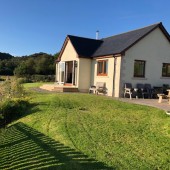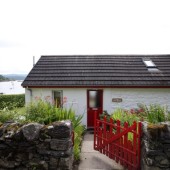Cygnets
The Cygnets group was started in 1995 to encourage children in the village to go boating safely. It was limited to primary aged children, and generally attracted up to 25 each Wednesday evening in the Summer. Supervision was provided by ten club members, all of whom had boating experience, and many more parents, who organized and kept a safety watch from the shore.
Three standards of Rowing Certificate were established. By the third the holder was deemed safe to launch and recover, row around the harbour on their own, pick up a buoy and come alongside a yacht. Then they could start sailing. Three standards of Sailing Certificate were also established.
The Club already owned two Toppers and was soon given another three and loaned a Gull and an Optimist. A Wayfarer was loaned by the Outdoor Centre at Achnamara.
Generous grants were obtained from A.I.E. ,the Sports & Arts Foundation and Rotary. These purchased a rescue boat, two outboards, three more Optimists and a Lark for the more experienced. Another rescue boat was loaned. In the second year, eight of the supervisors passed their RYA Dinghy Instructors Certificate, three more were awarded Safety Boat Certificates and the Club became an RYA recognised teaching establishment.
Year three saw six parents passing their RYA 1 and 2 Dinghy Certificates and joining in as instructors! At the Tayvallich Regatta, the children have their own racing and in 1999 were joined by six from Ardfern Sailing Club. The newly qualified parents also staged their own special race.
Regular rowing and sailing training is the main activity for the children. However other activities such as capsize drills in the swimming pool, learning about rights of way, buoyage and knotting have been carried out in the winter or on wet and windy evenings. A visit to Tayvallich by the new Islay Lifeboat was a thrill for both children and instructors. A couple of times each season, an evening is spent sailing local cruising yachts and the annual barbeque, usually held in the Fairy Islands, is the highlight of the year.
-
Rowing 1
-
Rowing 2
-
Rowing 3
- Can be accompanied and prompted by instructor or do it solo.
- Board dinghy from pier, assistance allowed
- Ship rowlock and oars
- Row round triangular course, max 200 metres. Make good progress, look ahead and show steering and stopping. Show ability in charge of boat.
- Return to pier and hand painter to shore helper
- Stow oars and rowlocks.
- Show how to summon help.
- Disembark, assistance allowed
- No assistance, no company in dinghy. Instructors on shore and on yacht or accompanying in another boat may prompt each stage of test.
- Board dinghy from pier and untie.
- Ship rowlock and oars
- Row out to yacht. Good straight line, avoiding buoys and boats. Come alongside from abeam holding/turning with outside oar, stowing inside oar and rowlock as dinghy approaches yacht. Demonstrate control of speed and course, minimum bump and no risked fingers.
- Hang on to yacht, stow other oar and rowlock. Tie up dinghy and board yacht confidently
- Reboard dinghy confidently, untying painter
- Ship outside rowlock and oar. Push off, shipping other rowlock and oar.
- Row towards shore.
- Disembark with painter and tie up sensibly and securely. (Round turn and two half hitches.)
- No assistance, no company in dinghy. Instructors on shore and on yacht or accompanying in another boat may prompt each stage of test.
- Demonstrate the skills in 1 and 2 above showing confidence and more than basic competence, i.e. rowing in wind and waves.
- Use one oar, by any means, to make progress and reasonable direction for about 25 metres.
- Pick up a buoy and tie up.
- Embark and disembark at slip or shore.
- Row backwards for about 25 metres.
- Turn 360 degrees on the spot.
- Do emergency stop, under control, from full speed
- Tie sheet bend and clove hitch
Note :-
Tests are done in this order, nobody may jump a test. Tests 2 and 3 may be done together.
No one sails alone until they have at least passed Rowing 2.
Section A: PRACTICAL
Rigging
1. Has wind awareness and knowledge of spars & rigging, parts of the sail, sail controls and foils.
Ropework
1. Can tie figure of eight knot, round turn & two half hitches and secure a rope to a cleat.
Sailing Techniques & Manoeuvres
1. Has wind awareness.
2. Understands the basic principles of the following manoeuvres:
a. Reaching – sailing across the wind
b. Stopping – lying-to
c. Controlling speed
d. Tacking – turning the front of the boat through the wind
e. Getting out of irons
f. Sailing upwind – sailing downwind
g. Gybing – turning the back of the boat through the wind
Launching & Recovery*
1. Can secure boat on trolley
2. Understands the principles of:
a. Wheeling a trolley – clear of other boats & overhead cables
b. Launhing & leaving the shore
c. Coming ashore & recovery of dinghy
d. Wind awareness
Section B: ONSHORE TEACHING
Sailing theory & Background
1. Aware of other water users
2. Has basic knowledge of rules of the road – port/starboard, windward boat, overtaking boat, power/sail
Meteorology
1. Awareness of onshore & offshore winds
2. Knows sources of weather information
Clothing and equipment
1. Knows importance of appropriate clothing, footwear and personal buoyancy
Capsize recovery*
1. Theory – knows importance of staying with the boatSection A: PRACTICAL
Rigging
1. Understands how to rig according to weather conditions. Able to reef ashore.*
Ropework
1. Can tie a bowline.
Sailing Techniques & Manoeuvres
1. Understands the basic principles of the following:
a. The Five Essentials – sail setting, balance, trim, course made good and centreboard*
b. Leaving and returning to a beach, jetty or mooring
c. Coming alongside a moored boat.
2. Knows basic rules of the road – port/starboard, windward boat, overtaking boat.
3. Aware of lee shore dangers, sailing in close company with others and man overboard recovery.
Launching & Recovery *
1. Has knowledge of dinghy storage ashore, launching and recovery.
2. Able to: paddle a sailing dinghy and row a boat around a short triangular course, come alongside and make fast.
Capsize Recovery *
1. Has practical experience of one method and knowledge of one other procedure.
Racing
1. Understands the course and starting procedure. (May be covered as onshore teaching).
Section B: ONSHORE TEACHING
Sailing theory and background
1. Has knowledge of:
a. Points of sailing
b. No Go Zone
c. Basic aerodynamic theory – how a sail works
d. Sea sailing - basic advice for inland sailors; local tide tables, tidal sequence springs & neaps, ebb & flow, taking local advice
e. Anchoring
f. Telling someone shore
g. Relationship between tide & wind
h. Relative speed with/against current
i. Estuaries & harbour mouths
j. Inland sailing – basic advice, local bylaws, permits, overhead power lines, locks and weirs.
2. Aware of the dangers of hypothermia and knows importance of first aid training, particularly in Expired Aid Resuscitation.
Meteorology
1. Knows sources of weather information, weather & shipping forecasts, when to reef.
Clothing and equipment
1. Knows importance of personal safety – clothing & buoyancy, boat buoyancy & basic equipment (anchor, paddle, bucket, bilge pump if fitted)
Emergency equipment & precautions
1. Knows importance of first aid kit, stowage and use of flares, visual methods of attracting attention, action to help those in distressSection A: PRACTICAL
Rigging
1. Able to rig boat using all the normal equipment
Ropework
1. Can tie sheet bend, clove hitch, fisherman’s bend and rolling hitch. Can heat seal and do a common whipping.
Launching & Recovery *
1. Able to leave and return to beach, jetty or mooring.
2. Understands windward and leeward shores and lee shore hazards.
3. Can use anchor to haul off.
Sailing Techniques & Manoeuvres
1. Understands crew co-ordination.
2. Is able to:
a. Sail a course to best advantage
b. Use a spinnaker (symmetrical & asymmetric) if fitted
c. Anchor – principles & techniques
d. Heave to
e. Reef afloat
f. Tow another boat and be towed
g. Recover man overboard
Section B: ONSHORE TEACHING
Racing
1. Understand mark rounding – wide in, narrow out
Sailing theory and background
1. Understands sea terms – windward, leeward, abeam, forward, aft, ahead, astern, to weather, downwind, amidships, quarter, pinching, sailing by the lee, luff, bear away, planing, sternway, broaching.
2. Knows the following International Regulations for Preventing Collisions at Sea :
a. Meeting other sailing vessels
b. Meeting power driven vessels
c. Following or crossing narrow channels
d. Action by stand-on vessels.
3. Able to plan a short passage
Meteorology
1. Knows sources of weather information – radio, television, newspapers, recorded telephone forecasts.
2. Can make simple interpretation of a synoptic chart
3. Knows main characteristics of high & low pressure areas.
4. Understands significance of major changes in barometric pressure.
5. Aware of changing weather conditions, Beaufort wind scale, fog dangers and prediction.
Capsize recovery *
1. Knows how to right an inverted dinghy ( this should be a practical session if possible).



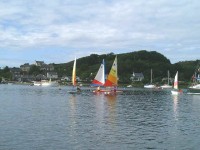

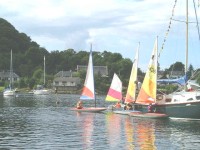



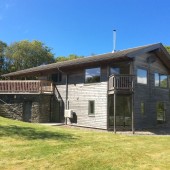


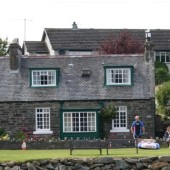
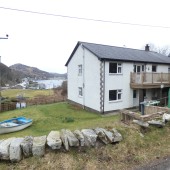
_baef36edc53bdd009ca06069d3b23fda.jpg)
